New Orleans: Let the Good Times Roll!🎷
The Big Easy delivers on its promise, with great food, jazz, art & unquenchable spirit

There was no shortage of advice when my husband Jeff and I let it be known that we were heading to New Orleans for a brief visit. That was especially true when it came to where to eat. After all, NOLA, as the city is often called (an acronym of its name and the state abbreviation, LA), is considered one of the world’s great food destinations, with a mind-bending culinary mix of cuisines reflecting its diverse history and population—French, Spanish, Creole, Cajun, African, Caribbean, Italian and more. And here we were with only four days to sample it! Too ambitious, as it turned out, but we still had a lot of fun—and ate very well!
NOTE: Be sure to check out Jeff’s PhotowalksTV New Orleans episode (airing Sunday at 3 p.m. ET on Scripps News and below) to see more the highlights of this great city and to learn more about how to capture images of them on your smartphone or camera.
Our visit began, not with food, but with music. We took part in what’s known in this city as a second-line parade. This is the band of revelers, many colorfully and elaborately costumed, that follow a funeral, wedding or other celebration, falling in behind a front line that often includes a brass band. These festive events generally occur on Sundays, and we arrived just in time to join the fun. As it was the day before St. Patrick’s Day, it seemed that many folks were wearing green—or perhaps it was just their usual attire!
At the French Market
After the parade, we made our way to the the famed French Market in the French Quarter. Also called “Le Vieux Carré” (literally “the old square”), it is the oldest neighborhood in the city, dating back to the city’s founding by the French in 1718. The open-air market, once a Native American trading post, predates the European colonists and is said to be the oldest in the U.S. There you can find all manner of local crafts—masks, baubles, beads, feathers, hats, soaps, even poetry for sale! And of course a panoply of local food and drink in all its splendid diversity.
There are signature dishes and curiosities at the many food stands, where you can eat to your heart’s content (though possibly your stomach’s upset!). As this was was my first glimpse of the culinary riches of NOLA, I spent my time gawking at the menu boards—thinking I ought to sample some of the more outrageous offerings (like “N’awlins Gator on a Stick”), but lacking the nerve. Most of the places closed before I had a chance to do more than buy a few pecan pralines—the signature, melt-in-your-mouth specialty of this city. Of course there was always the next day—but then we were already booked to take a walking and eating tour in the city’s Garden District.


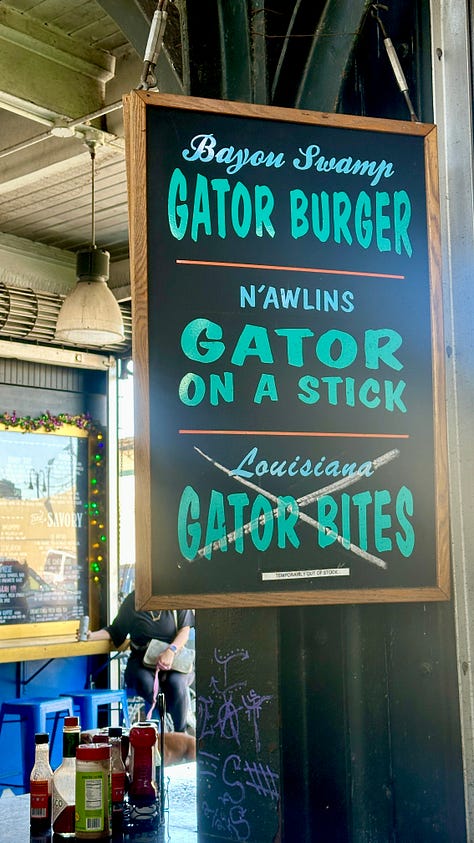
But before that, at the end of the French Market, we found another famed landmark, the Café Du Monde, a definite must, we’d been told. Open 24 hours a day, its draw is the famous beignets (pronounced “beh-nyay”), along with coffee with chicory, served black or “au lait,” my favorite, half coffee, half milk. Iced coffee and orange juice have also been added to the limited menu.
Café Du Monde attracts crowds and long lines, which wax and wane, depending on the time of day and year. The beignets, warm squares of deep-fried dough similar to a doughnut, minus the hole in the center and with a hollow pocket inside the puffed pastry, are served three to a plate, sprinkled with mountains of powdered sugar that inevitably end up on your face, hands and clothes as well as in your mouth. I imagined they’d be too sweet and intended to eat only one, but couldn’t help devouring all three. Consumed along with that slightly bitter chicory-infused coffee, there’s nothing better!
More ‘bon temps’1
“What do you mean you didn’t visit Commander’s Palace,” Jeff’s friend Chris scolded him after we returned from our trip. Sitting here writing this and perusing the menu for the 145-year-old restaurant’s fabled jazz brunch (Turtle Soup au Sherry, Ponchatoula Strawberry Cheesecake Pain Perdu, Escargot Bourguignon en Croûte), I feel pangs of guilt at presuming to write about this city without setting foot in what is probably its most famous restaurant and winner of seven James Beard Foundation awards.
But my notoriously fussy hubby, who proudly owns up to having the tastebuds of a 6-year-old, tells me he wouldn’t have found much on what is described as a “Modern New Orleans cooking meets Haute Creole” menu that he could eat—definitely not turtles, snails or quail!

I did take a picture of the restaurant’s distinctive turquoise-and-white-striped facade as we wandered around the picturesque and very walkable Garden District with our tour guide Michelle Mashon. She introduced us to some other architectural landmarks and neighborhoods, the city’s famed live oak trees and a few of the off-the-beaten track eateries and shops on Magazine Street. All of it definitely requires a return visit!
Visiting a Legend: Dooky Chase’s Restaurant
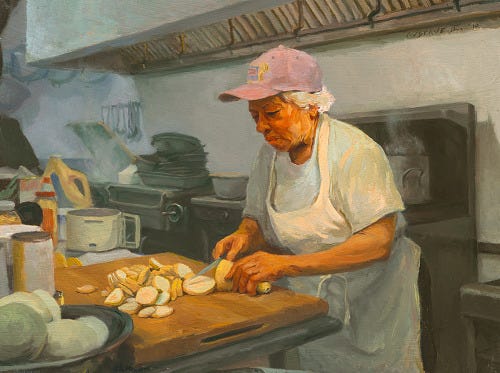
“I like to think we changed the course of America in this restaurant over a bowl of gumbo.”
—Leah Chase, the late chef and co-owner of Dooky Chase’s Restaurant
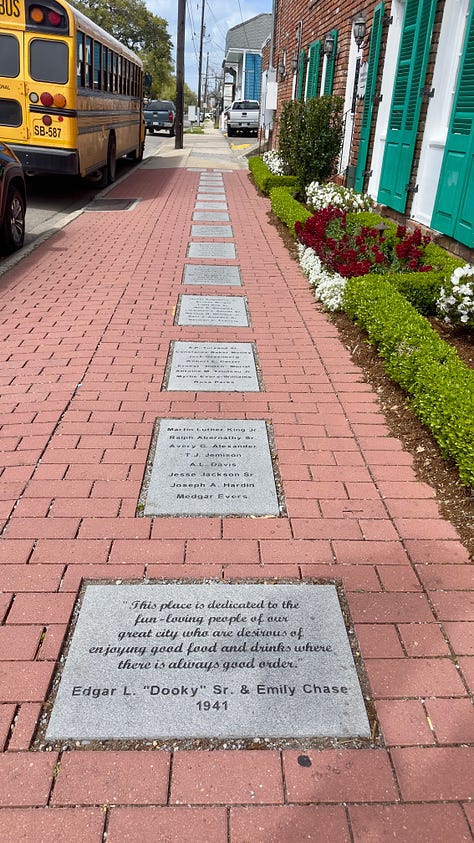

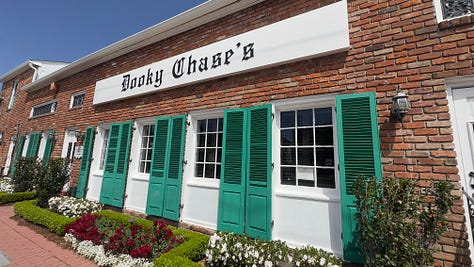
It’s a kick standing outside historic Dooky Chase’s Restaurant in NOLA’s Tremé neighborhood and gazing at a who’s who of civil rights, sports, music, film, literature and politics—Martin Luther King, Jr., Medgar Evers, Rosa Parks, Muhammad Ali, Louis Armstrong, Duke Ellington, James Baldwin, Cicily Tyson, Shirley Chisholm, Barack Obama and Hillary Clinton—immortalized in plaques embedded in the brick sidewalk. Many mixed-race gatherings to plan strategies for desegregation in 1950s and 1960s took place in an upstairs room at a time when such meetings were illegal.
And then there’s the restaurant’s reputation for great Creole cooking2—rich gumbos, red beans and rice, chicken Creole, jambalaya—and for its celebrated executive chef Leah Chase, who passed away in 2019 at the age of 96, working her magic in the kitchen to the very end. Dubbed “the Queen of Creole Cuisine,” she fed many of those whose names are on the sidewalk in front—including Quincy Jones, Duke Ellington, Ray Charles, Beyoncé Knowles, and Presidents Bush and Obama. A portrait of Obama giving her a hug hangs in the entrance (see above).
The eldest of 11 children in a Catholic Creole family, Leah married Edgar “Dooky” Chase, Jr. in 1946 and, with grit, vision and clearly some deep-seated culinary chops, turned what was originally a barroom, lottery ticket hub and sandwich shop into one of the first African American fine dining restaurants in the nation.
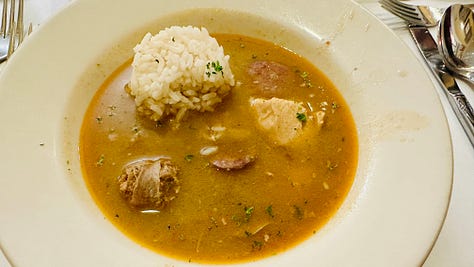
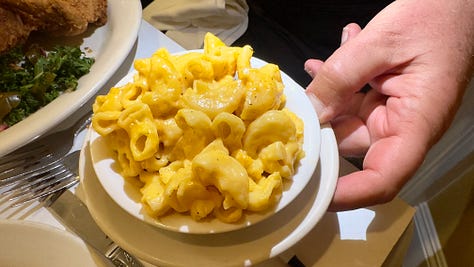



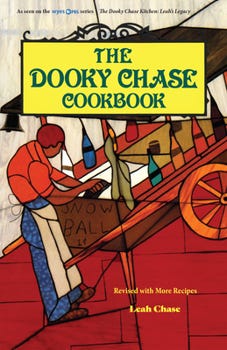
Feasting on Creole gumbo, deep-fried chicken and shrimp, jambalaya, baked macaroni and pecan pie, it felt like we were experiencing sensory overload, digging into one delicious dish after another while gazing around at the wide variety of African American art on the walls. The gumbo, less thick than some I’d eaten, had a subtly spicy broth, with pieces of shrimp, blue crab, sausage and chicken, and topped with a little mound of white rice. Jeff’s fried chicken was juicy and tender, and my battered shrimp, dipped in cocktail sauce and sprinkled with lemon, were addictive.
The baked macaroni was creamy and rich, and I was glad to walk away with a copy of The Dooky Chase Cookbook, which includes the recipe (click here to see it). The book also has recipes for other dishes on the menu, like Creole jambalaya, several varieties of gumbo, and fried chicken. Not on the menu but in the cookbook: squirrel stew and squirrel pie. Of the pie, Leah Chase writes:
“You have to steam the squirrel until it is tender, pick it all off the bone, and then you make your sauce and put it in a spicy crust. If I don’t have enough squirrels to do pies, I have found they make good ‘critter gumbo’ when combined with venison sausage. Squirrel pie, though, is worth the effort.”
Though we do have a plenty of squirrels in my neighborhood—and they’re annoying enough to deserve to be made into a pie or gumbo—I think I’ll stick to chicken!
More eats
While the culinary highlight of our NOLA visit was easily Dooky Chase, we had memorable food and experiences everywhere we went, from the traditional dishes, classical music and moody decor of The Napoleon House in the French Quarter, to seafood gumbo and half a messy but scrumptious roast beef po’boy sandwich at the lively Acme Oyster House, to the wild, over-the-top sandwiches on a windy patio at Turkey and the Fox in the lower Garden District, to the inventive take on red snapper (atop a bed of brussel sprouts, collard greens, pickled cauliflower and radishes in a pumpkin broth) at trendy BABs in the Faubourg Marigny/Bywater neighborhood, to the rich duck in Port wine sauce and pickled blueberries at Copper Vine Wine Pub & Inn in the city center. We really didn’t have a bad meal!

And all that jazz!
As famous as New Orleans is for its food, it’s equally celebrated for its music. It’s widely considered to be the birthplace of jazz, whose roots may be traced back to Congo Square in what is now called Louis Armstrong Park. That’s where enslaved folks and free people of color used to gather in the 19th century for meetings, dancing and drumming sessions (and it’s worth a visit too!).
You can’t take a step anywhere in the city without hearing brass horns tooting, drums beating, someone singing or dancing, and a crowd hooting and clapping in appreciation. It’s a thrill and can’t help but bring a smile to your face, no matter your mood at the start of the day.
The two biggest standouts for us were hearing a seven-piece band perform at Preservation Jazz Hall and catching a brass band playing on Frenchmen Street, considered one of the best thoroughfares to enjoy live jazz in New Orleans. Here’s a clip of a dancing crowd enjoying the One-Way Brass Band performing in front of Willie’s Chicken Shack on Frenchmen Street. If you look closely, you’ll see a little girl in front beating on a drum! She’ll probably be leading the band in a few years!
Unfortunately, we weren’t allowed to take pictures inside Preservation Jazz Hall, a venerated venue for traditional New Orleans jazz since 1961, but after a lively 45-minute set, Jeff asked trombonist Ronell Johnson to play “When the Saints Go Marching In” for his PhotowalksTV series.
When I asked Ronell to share his thoughts about the food in New Orleans, he gave me a mouthful—especially about the gumbo, which he said, gets “the slow clap” for its many delicious variations. I was ready to put my hands together not only for his music but for that jazzy shirt too!🎼
A quick visit to NOLA’s ‘Cities of the Dead’
Of course there was more, including stopping by some of the oldest and best-known of New Orleans’ 41 cemeteries. Our guide Rob Florence wrote a book on the subject, New Orleans Cemeteries: Life in the Cities of the Dead, with his brother Mason.
The famous phrase “Let the good times roll” epitomizes the city’s spirit of revelry and resilience, he told us. There’s been a lot of suffering—as in the aftermath of Hurricane Katrina in 2005 and long before that for the many who died of epidemics—like the yellow fever that killed 41,000 people over the course of the 19th century. “The city is populated by a lot of people who historically haven’t had a good time. There’s been a lot of suffering, yet people have overcome,” Rob said.

The cemeteries, filled with monuments to the dead, almost all built above ground because of the the city’s low elevation and high water table, have become its museums, Rob told us. Unlike in most places where death is feared, it’s celebrated in NOLA with jazz funerals and elaborate monuments that often hold several generations of a single family. “People here are born knowing where they’ll be buried,” he said.
And finally, Red Beans & Rice
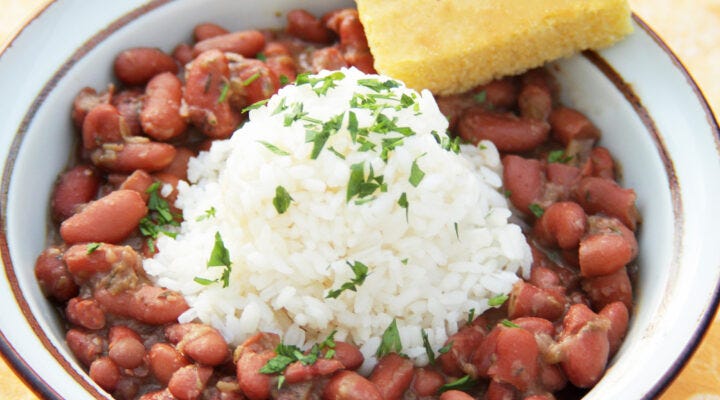
I returned home from New Orleans with as many goodies as I could pack into my suitcase, including cookbooks, spices and a couple of pounds of Camellia red beans. I heard tell that Camellia was the only brand to use when making red beans and rice. The dish is closely identified with New Orleans Creole culture, with one oft-told story being that in years gone by, it was popular to make it on Mondays, flavoring it with a hambone leftover from Sunday dinner.3
“The first day of the week was washing day, and the woman responsible for providing a household with a clean set of clothes was also obligated to feed the household that evening. Cleaning and cooking left little time and attention for both, so a pot of red beans was left on the stove, simmering long and gentle throughout the day.”
Beans are also popular in my household, so I made the dish according to the recipe on the Camellia website. Instead of a hambone, I used a smoked turkey thigh bone, then added the chopped meat and sliced, smoked chicken sausage to the cooked beans before pouring them over some cooked long-grain white rice. The dish didn’t look quite the way it did on the website or when we consumed it in the Big Easy—but we enjoyed it just the same! Lucky me—I still have another pound of red beans to cook, perhaps in a different way. Any ideas?
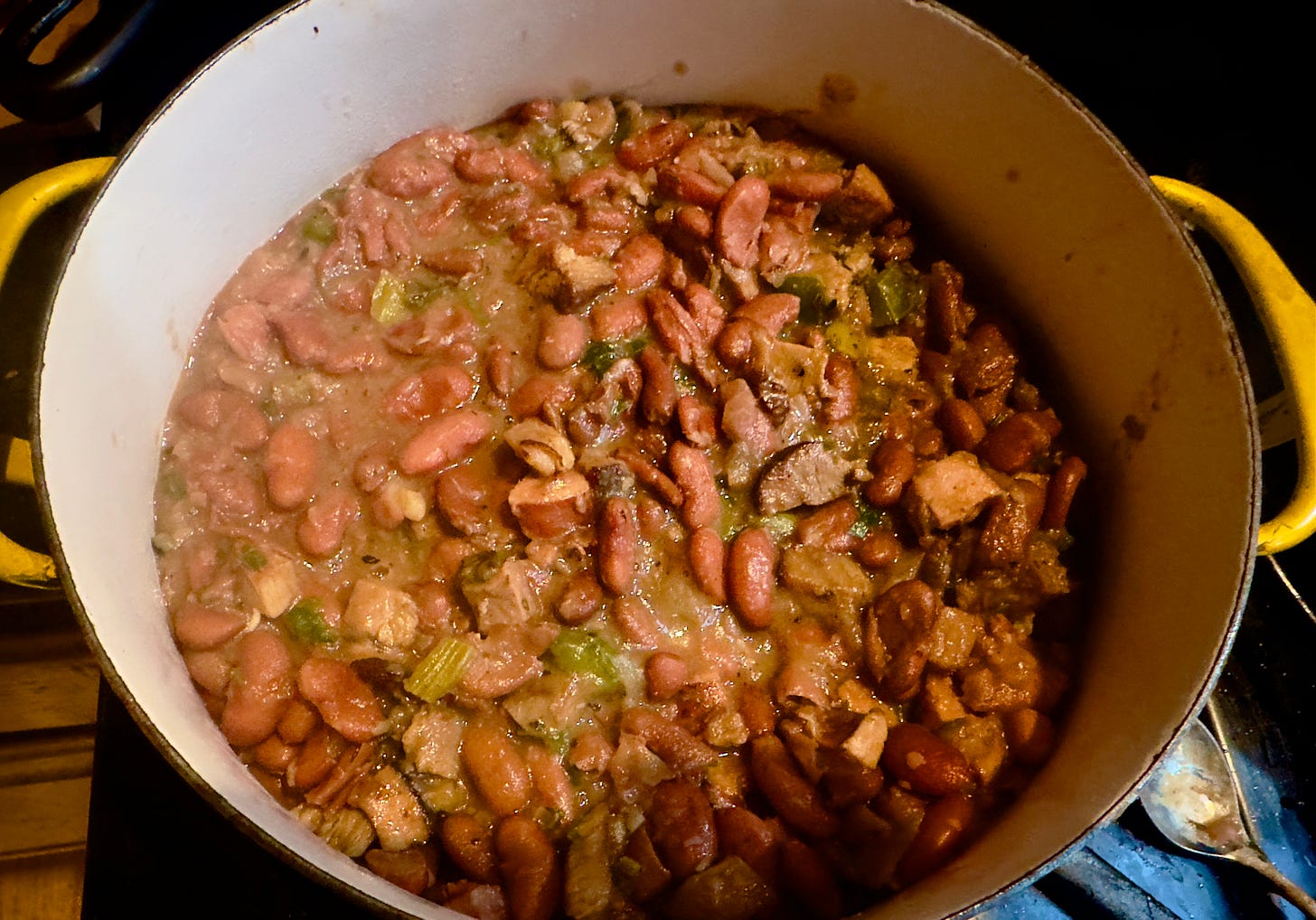
Thanks so much for reading! If you enjoyed this post, please let me know by clicking on the heart, leaving a comment, sharing it with others and—if you’re not already—becoming a subscriber. I’ll be forever grateful.
See you soon!
Ruth
“Laissez les bons temps rouler” is a Louisiana French phrase that is translated from the English “Let the good times roll.” It is said to epitomize the joie de vivre (a true French phrase meaning joy of living) that characterizes the New Orleans lifestyle. In standard French, “Laissez les bons temps rouler” would probably be “Que les bons moments roulent!” There are disputes as to the origin of both the English and French phrases, though most trace it back to a song recorded by Louis Jordan in 1946. To read more, click here.
According to an article in Wikipedia, Louisiana Creole food represents “a blend of the various cultures that found their way to [the state], including French, Spanish, Acadian, Caribbean, West African, German and Native American, among others.” While both Creole and Cajun food draw on French cooking traditions, “Creole cuisine is stereotypically considered more ‘city food’ while Cajun cuisine is considered simpler ‘country food.’” From our brief sampling of the local cuisine, it seems there is a great deal of overlap between the two styles.
For more red beans and rice lore, check out this post titled “A Tale of Red Beans and Rice” on the Camellia website.

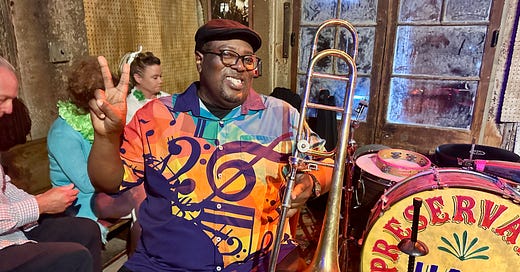





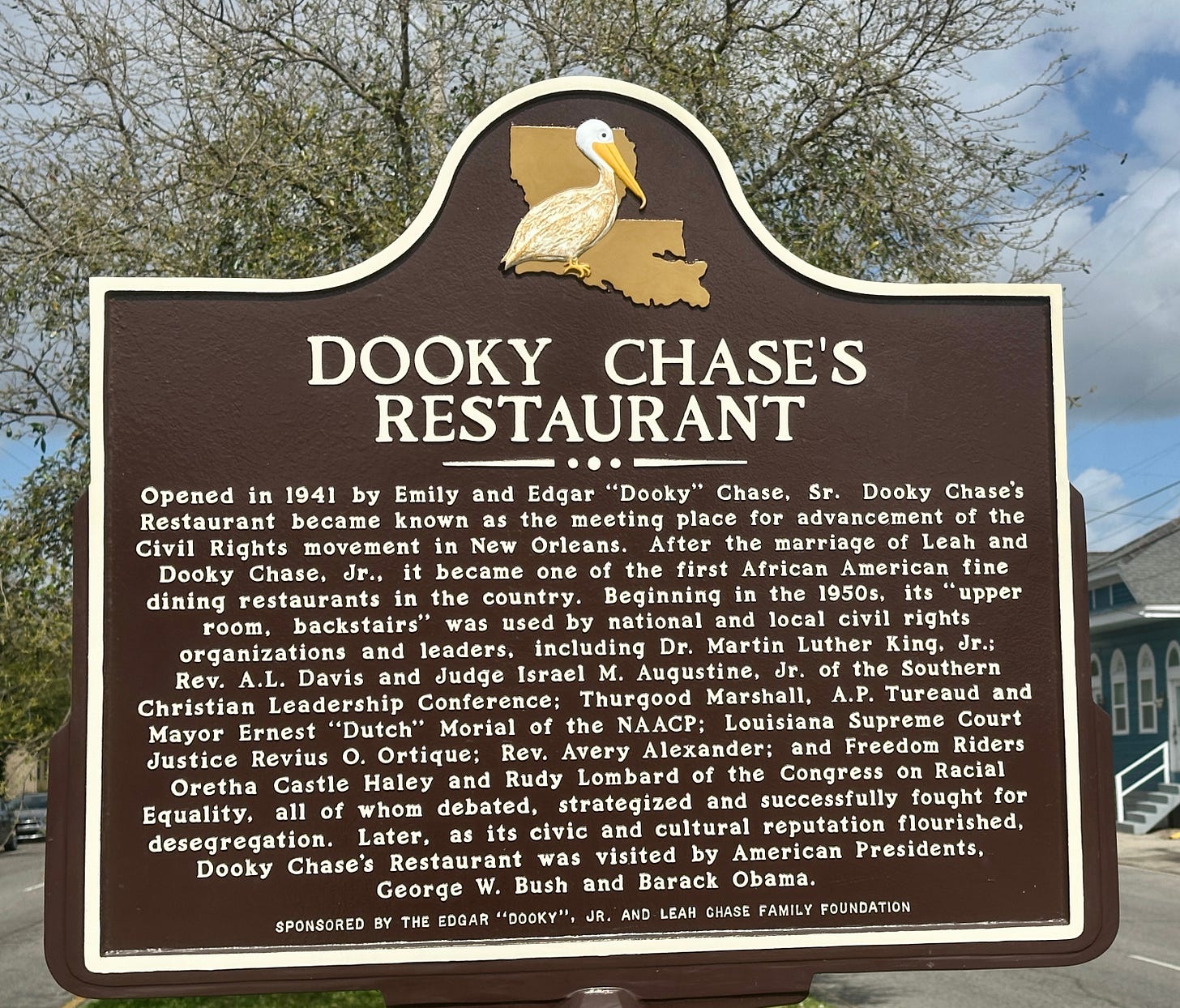
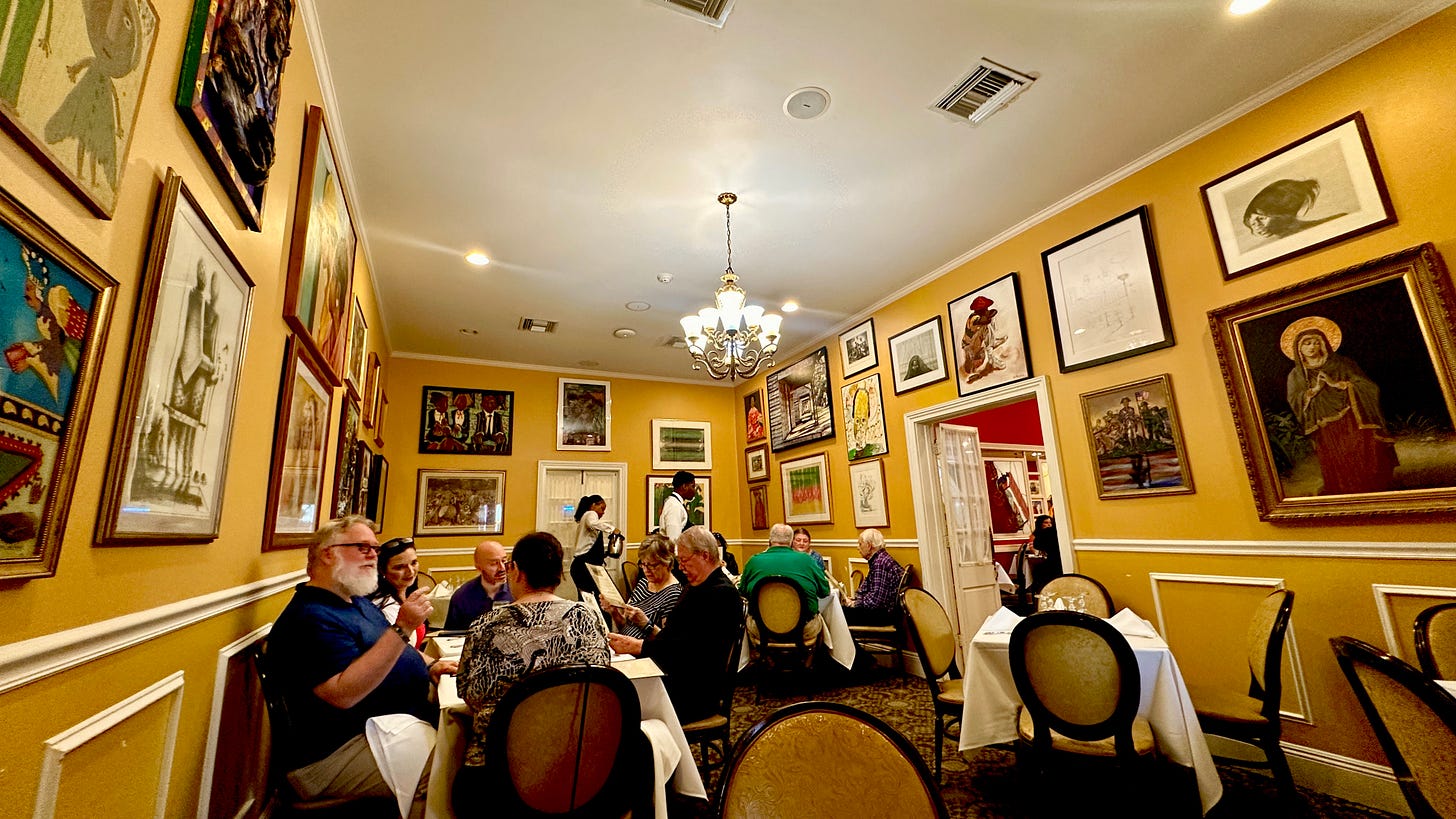
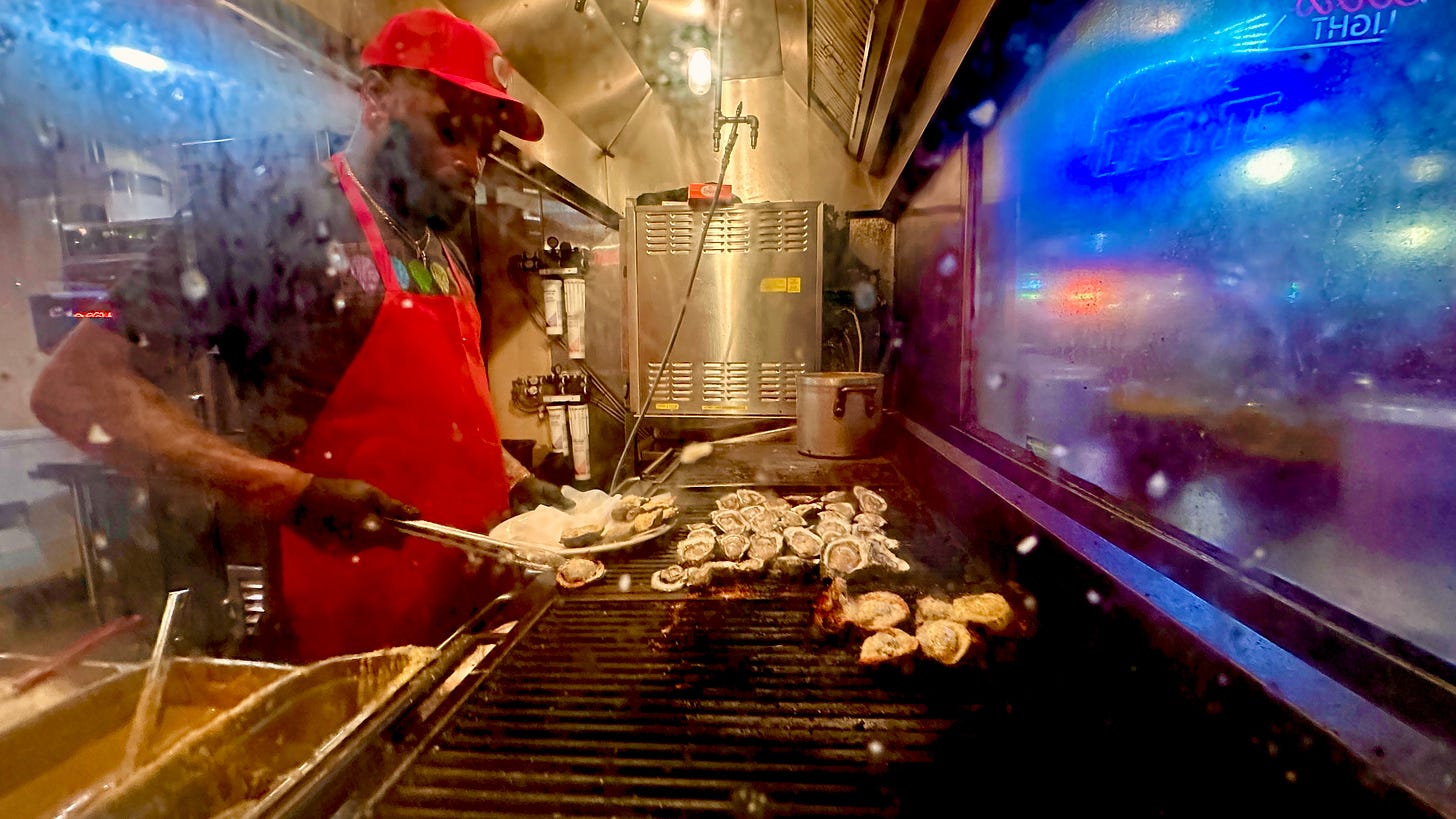

Excellent article. Enjoy your food and writings .
So you missed "Commander's Palace" just means you have to return to NOLA
Judy Truex Reed
Looks like you had a fabulous visit, @Ruth, and found plenty of great food!
Your husband can definitely find something yummy at Commander’s Palace - I’m not a big spice or weird food eater either, and have always walked out of there happily fed 😉 plus the service is spectacular!
One of my favorite NOLA books is “Miss Ella of Commander’s Palace” which tells the story of the restaurant’s founder. What a woman - I’ve an idea you’d love it.
Thanks for sharing your trip with us!